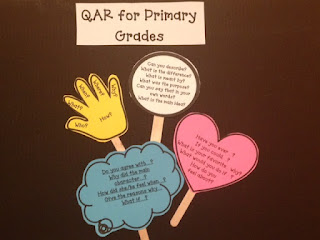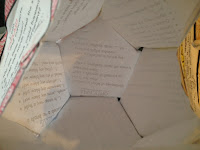I
was very hesitant to open an email from Marianne at Teach to be Happy because I figured it was a spam or an April Fool's Day joke. I'm happy to say that Marianne nominated me for a Leibster Award! This is a recognition award for new bloggers that have less than 200 followers.
So, here are the rules of being nominated:
1. You must post 11 random things about yourself.
2. Answer the questions that the nominator set for you.
3. Create 11 questions for the people you nominate.
4. Choose 11 other blogs with fewer than 200 followers to nominate and link them in your post.
5. You cannot "tag back" the other blog, but leave a comment on this post with the URL of your Liebster
post so I can learn learn more about & see whom you nominate.
11 Random Things about ME!
1. I love to create materials for teachers to use in their classrooms.
2. I have been facilitating workshops for over 25 years.
3. Before retiring, I taught all grades K-5.
4. I love my job as a teacher coach.
5. I have been listening to Adele 21. Love it!
6. I am loving a new book by Harvard researchers at Project Zero, Making Thinking Visible.
7. I have two grown children and a 4 year old granddaughter.
8. My husband is a saint for supporting me always.
9. I enjoy riding on the back of my husband's Harley!
10. I'm always on the search for a new recipe. Today it's a Foodnetwork generic recipe that can be modified to make 5 different rolls. I'm going to start with the Lemon Poppyseed rolls.
11. My goal is to make a quilt someday.
My Answers to Teach to be Happy
1. What is your favorite thing to do when you get home? My favorite thing to do when I get home is to check my emails and get everything done before I start thinking about my next project.
2. File cabinet or digital files? My computer just crashed and I lost all my files that I created over Christmas break, but I still would say digital files. I just back up better now.
3. What inspired you to become a teacher? I had a great music teacher in high school that inspired me but I also have always loved teaching. As a teacher coach, now I get to teach teachers and model lessons for students.
4. What is your funniest student story? I remember when I got a new student named Christopher. The first thing he said to me was, "I beat up my last teacher!" I replied, "I'll tell you what, Christopher. If you hit me, we'll both be bloody when the police arrive." He turned out to be one of my best students.
5. If you could be a kid again, what would you play with? I would love a pair of metal skates to hook onto my shoes so I could skate around the block on the sidewalk.
6. What is your favorite spot in your school? My favorite spot in a school is the media center with the kids and the books.
7. What do you do with your class that others don't do with theirs? Everything I did with my class was pretty much hands-on. It's the only way to learn.
8. What is the secret to teaching success? The secret to teaching success is to never stop growing and learning.
9. If you could redesign your classroom, what would you change? I think every classroom needs working walls (anchor charts, vocabulary etc.) and different "areas" for learning like whole group, small group/hands-on work and individual quiet spaces.
10. What is your favorite school lunch? I love soup and a baquette from Panera's. The only problem is that I have to purchase it the night before.
11.How much time do you spend on school things outside of the school day? I get up at 5:00 am and I go to bed around 9:30 pm. Most of that is dedicating to working at school or working on school at home. Thank goodness my husband is a saint that rides a Harley!
My Questions for You!
1. How do you balance your life at school and your life at home?
2. What do you like best about teaching?
3. If you could change one thing about your job, what would it be?
4. What are you focusing on now as a teacher?
5. Who supports you in your journey as a teacher?
6. Have you read any good books lately?
7. Any hobbies?
8. What is the secret to teaching success?
9. How do you manage everything that needs to get done in one day?
10. How do you stay current with the research?
11. What do you think of the Common Core Standards?
My Nominated Blogs:


.JPG)
.JPG)







.JPG)













